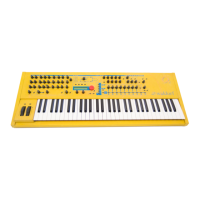Sound Parameters – Oscillators
67 Waldorf Q User’s Manual
The Sawtooth Wave
The Sawtooth Wave is the most popular synthesizer waveform. It consists of all harmonics where the
magnitude of each harmonic descends by the factor of its position. This means that the first harmonic
(the fundamental) has full magnitude, the second harmonic has half magnitude, the third harmonic
has a third magnitude and so on. The following picture shows how the individual harmonics build up
the sawtooth wave:
14 81216
Frequency
Magnitude
Time
Amplitude
+
=
1st Harmonic
Magnitude 1
2nd Harmonic
Magnitude 1/2
3rd Harmonic
Magnitude 1/3
4th Harmonic
Magnitude 1/4
Harmonics
+
+
+
.
.
Picture 11: Additive components of the Sawtooth wave
The sawtooth wave was thought as an abstraction of the timbre of string and brass instruments. You
can easily understand that when you think of a violin. Imagine a bow pulling the string slightly into
one direction. At one point, the string abruptly comes off the bow and swings back to its original
position. The bow is still moved and so it catches the string again and the procedure is repeated. The
result is a waveform that looks like a sawtooth. The same is true for a brass instrument. The string in
this case are the lips while the bow is the air. The lips are moved by the air to a certain extent and
abruptly move back to their original position.

